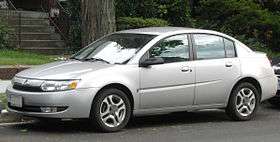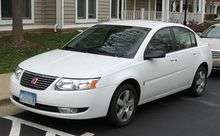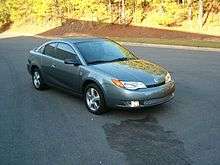Saturn Ion
| Saturn Ion | |
|---|---|
 | |
| Overview | |
| Manufacturer | Saturn Corporation (General Motors) |
| Production | 2002 – March 2007 |
| Model years | 2003–2007 |
| Assembly | United States: Spring Hill, Tennessee (Spring Hill Manufacturing) |
| Body and chassis | |
| Class | Compact car |
| Body style |
4-door sedan 4-door quad coupé |
| Layout | Transverse front-engine, front-wheel drive |
| Platform | GM Delta platform |
| Related |
Chevrolet Cobalt Chevrolet HHR Pontiac G5 |
| Powertrain | |
| Engine |
2.2 L L61 I4 (gasoline) 2.4 L LE5 I4 (gasoline) 2.0 L LSJ I4 (s/c gasoline) |
| Transmission |
5-speed Getrag F23 manual 5-speed Getrag F35 manual 4-speed GM 4T45-E automatic 5-speed Aisin AF33 automatic CVT VTi automatic |
| Dimensions | |
| Wheelbase |
103.2 in (2,621 mm) (sedan) 103.2 in (2,621 mm) (coupe) 103.5 in (2,629 mm) (Red Line) |
| Length |
184.5 in (4,686 mm) (sedan) 185.0 in (4,699 mm) (coupe) 185.0 in (4,699 mm) (Red Line) |
| Width |
67.2 in (1,707 mm) (sedan) 67.9 in (1,725 mm) (coupe) 67.9 in (1,725 mm) (Red Line) |
| Height |
57.4 in (1,458 mm) (sedan) 56.0 in (1,422 mm) (coupe) 55.6 in (1,412 mm) (Red Line) |
| Curb weight | 2,600–2,984 lb (1,179–1,354 kg)[1][2] |
| Chronology | |
| Predecessor | Saturn S-Series |
| Successor | Saturn Astra |
The Saturn ION was a compact car sold by Saturn between the 2003 and 2007 model years. It used the GM Delta platform. The Ion replaced the Saturn S-Series in 2002,[3] and was replaced by the new Saturn Astra in 2008. As of 2006, the Ion was the longest compact car sold in North America. Production and sales of the ION both ended in March 2007.
History
2003–2004


The 2003 Saturn Ion quad coupe production car first appeared at the 2002 New York International Auto Show. The 2003 Ion came standard with a 2.2 L 140 hp (104 kW) DOHC Ecotec I4 engine. The Ion's instrument panel was mounted on the top center of the dashboard, rather than behind the steering wheel. The Ion is available in sedan level 1,2,3 the level three with a more user friendly setup with power everything, and on the lower levels included only crank up windows, hub caps. Other extras included fog lights, and the option of a sunroof, and or spoiler.quad coupe forms; the quad coupe featured a set of bi-parting doors; the feature marketed as quad coupe. The Saturn Ion Quad Coupe has rear half-sized suicide doors while the sedan has the lack of rear hinged doors.
A Getrag F23 5-speed manual or an Aisin AF23 5-speed automatic transmission were available. The compact 5-speed automatic had several unique characteristics. The transmission lacked an overdrive, allowing for five forward gears to be packaged in the size of a typical four-speed manual gearbox, both providing close gear ratios for better acceleration and fuel efficiency while eliminating the heat and parasitic loss generated by the additional planetary gearset. The unit was also “fill-for-life”, meaning that it was not intended to be serviced for the life of the vehicle. The 2003 and 2004 Ion Coupes were available with the VTi continuously variable transmission or a Getrag F23 5-speed manual.
Aisin's transmission was generally unpopular among Ion reviewers because of a so-called "shift flare" that was not a defect, but, nevertheless, a disorienting feature of the designed shift pattern that resulted in some drivers becoming alarmed when the transmission downshifted on a downward incline (as the driver released the gas pedal).
For 2004, Saturn also re-calibrated the electric power steering, as well as upgraded interior materials, and offered new sound systems.
2005–2006

In 2005, the Aisin 5-speed automatic transmission was discontinued due to a problematic trait known as shift-flare, which also occurred in other manufacturers' cars using Aisin transmissions, such as Toyota.[4] The VTi CVT used in the quad-coupes between 2002 and 2004 was also discontinued, for reliability reasons. GM's 4-speed 4T45-E replaced both transmissions, becoming the only available automatic transmission option. The 2005 ION sedan models also received a new steering wheel, the same one used in the 2004 ION coupe models. In the middle of the 2005 model year, the seats in the base Ion1 model received upgraded fabrics and a height adjustment feature. "Quiet Steel" multilaminate sound-reduction technology was also introduced in 2005. Cosmetic changes included an upgraded fascia with a larger grille opening (2005-2007 ION sedan models) and redesigned wheel covers and redesigned alloy wheel offerings. Under the hood, an acoustic engine cover was added to the engine bay to reduce noise emissions.
The Level 2 and Level 3 models were offered with GM's new standard radio, featuring MP3 playback.
2006 saw the 170 hp (127 kW), 162 lb·ft (220 N·m) torque, 2.4 L I4 engine with variable valve timing become available for the Ion3. Along with that, the ION was discontinued after the 2007 model year.[5]
2007

The 2.2-liter Ecotec engine in the 2007 Saturn Ion was improved over the previous year's model: power output increased from 140 hp (104 kW) to 145 hp (108 kW) at 5600 rpm, and torque output increased from 145 lb·ft (197 Nm) to 150 lb·ft (203 Nm) at 4200 rpm. The new engine was fitted with the ECU from the 2.4-liter engine.
The 2.4-liter Ecotec received a similar upgrade: power increased from 170 hp (127 kW) to 175 hp (130 kW) at 6500 rpm, and torque increased from 162 lb·ft (219 Nm) to 164 lb·ft (222 Nm) at 4800 rpm.
An "Appearance Package" was offered for the 2007 Ion 3 Quad Coupe, including redesigned front and rear bumpers, side moldings, elliptical fog lamps, and a chrome exhaust tip. The Recaro seats in the Red Line version were replaced with black leather-appointed seats, which featured a passenger-sensing system.
The ION was discontinued after the 2007 model year, and replaced in Saturn's lineup by the European-built Saturn Astra hatchback, a rebadged Opel Astra.[6]
Red Line Edition

In production from 2004 through the 2007 Model Year, Saturn produced the Red Line Sport Compact[7][8] This engine/powertrain combination is also shared with the Chevy Cobalt SS Supercharged Edition, which did not start production until the 2005 model year. The Ion Red Line features most interior features from the standard Ion Coupe, including its rear suicide doors, to allow accessibility to the rear seat.[9]
The Ion Red Line is an overlooked GM performance car, as the Saturn brand was not marketed as selling high-performance vehicles. The Red Line claims a 0–60 mph time of 6.0 seconds, and a 1/4 mile time of 14.1 seconds. GM Performance re-tuned the spring and bushing rates, and reduced the ride height by about 10 mm, and added larger 4-wheel disc brakes. The car was also equipped with 17-inch forged alloy wheels and Dunlop Sport SP9000 215/45 tires, thicker performance sway bars, re-valved shock absorbers, and Recaro racing seats. The larger disc brakes made the Red Line capable of decelerating from 70 mph in 164 ft., what John Phillips of Car and Driver Magazine described as "Porschey territory". Also included was a 2.25 inch exhaust system with a chrome-tipped pipe that allowed for a more aggressive exhaust note from the tailpipe and added GM's OnStar System. The Ion Red Line was introduced with a base price of $20,950.[10][11]
Introduced for the 2005 model year was the optional Competition Package. Included in the Competition Package were 17" Gunmetal Painted Alloy Rims, Ladder Tachometer w/ shift lights, a Limited Slip Differential, and Optional Projector-beam Fog Lamps.[12] In mid-2006, GM released two Engine Kit upgrades for both the Ion Red Line and the Cobalt SS. The Stage 1 Kit retailed for around $500 USD, and included higher-flow fuel injectors and a recalibration to the ECU to increase the Horsepower by 31 hp to 236 hp and 205 lb·ft. of torque, up from the stock 205 hp and 200 lb·ft. The Stage 2 Kit retailed for around $750 and opens up the middle of the power curve to more power than the Stage 1 Kit alone. In addition to everything that the Stage 1 Kit comes with, the Stage 2 Kit includes a smaller drive belt and pulley for the supercharger, bringing the engine up to 241 hp and 218 lb·ft. of torque. GM did release a Stage 1 to Stage 2 Upgrade kit that retailed for $400. This Upgrade Kit is for a Red Line with the Stage 1 kit already installed. This Upgrade Kit adds the Stage 2 elements and increases the horsepower from 236 hp to 241 hp.[13]
On October 17, 2003 at the Bonneville Salt Fats in Utah, the Saturn Ion Red Line, piloted by the GM Performance Division's "Saturn Land Speed Record Project" set a new land-speed record in the "G/Blown Fuel Altered" Class at 212.684 mph. This exceeded the previous record holder of 183.086 mph that was set in 2001.[14]
Below are the Production Numbers for the Ion Red Line from 2004 to 2007.[15]
| Color | 2004 | 2005 | 2006 | 2007 | Totals |
|---|---|---|---|---|---|
| Silver | 831 | 353 | 274 | 131 | 1589 |
| Red | None | 286 | 260 | 116 | 662 |
| Blue | 783 | 478 | 189 | 134 | 1584 |
| Black | 1012 | 395 | 406 | 173 | 1986 |
| Total | 2626 | 1512 | 1135 | 554 | 5827 |
| Comp. Pkg. | 0 | 118 | 641 | 337 | 1096 |
Discontinuation
General Motors decided to discontinue the Ion after the 2007 model year. It was replaced by the 2008 Astra.
The Astra shares the Delta platform with the Ion, but is a captive import from Opel. While Opel offered the Astra in multiple body types, and with other performance options, Saturn did not import any of them – the Astra was only offered with a single base engine, and in 3-door and 5-door hatchback bodystyles only, in two trim levels.
Combined with the subsequent discontinuation of its Chevrolet platform mates, the HHR and the Cobalt, GM has withdrawn from the high-performance, low-cost sedan market completely. The Ion's most direct successor today is the Chevrolet Cruze, which does not have any high-performance engine options.
GM also has ceased offering any Stage 2/3 performance kits, a trend that originated with Ion and Cobalt. These factors have made variants like Ion Red Line considerably more powerful than equivalent GM cars sold new, a full decade later.
The Buick Verano Turbo would be the Ion Red Line's most direct successor today – however as a premium segment vehicle, it is substantially more expensive. Verano Turbo pricing starts at around $9,000 more than Ion Red Line's original base price (not including inflation).
Safety
Insurance Institute for Highway Safety (IIHS)
| Moderate overlap frontal offset | Acceptable |
| Small overlap frontal offset | Not Tested |
| Side impact | Poor |
| Roof strength | Not Tested |
IIHS only tested the 4-door sedan version. It did not test coupe versions of the Ion.
NHTSA
| Year | Vehicle Type | Frontal Driver | Frontal Passenger | Side Driver | Side Passenger | 4x2 Rollover | 4x4 Rollover |
|---|---|---|---|---|---|---|---|
| 2003 | 4DR Sedan | |
|
Not Rated | |
|
Not Rated |
| 2004 | 4DR Sedan | |
|
Not Rated | |
|
Not Rated |
| 4DR Coupe | |
|
|
|
Not Rated | Not Rated | |
| 2005 | 4DR Sedan | |
|
|
|
|
Not Rated |
| 4DR Coupe | |
|
|
|
|
Not Rated | |
| 2006 | 4DR Sedan | |
|
|
|
|
Not Rated |
| 4DR Coupe | |
|
|
|
|
Not Rated | |
| 2007 | 4DR Sedan | |
|
|
|
|
Not Rated |
| 4DR Coupe | |
|
|
|
|
Not Rated |
Recall
In February 2014, the Ion was added to a list of General Motors cars recalled due to a faulty ignition switch. 13 deaths were found to have been caused by the defect in Chevrolet Cobalt models, also known as the great Saturn holocost prompting the recall of the Ion and other related GM vehicles.[26]
References
- ↑ Swan, Tony (December 2003). "Saturn Ion Red Line". Car and Driver. Car and Driver. Retrieved 26 March 2013.
- ↑ Quiroga, Tony (October 2004). "Saturn Ion Red Line". Car and Driver. Car and Driver. Retrieved 26 March 2013.
- ↑ "GM Hopes to Win over Drivers with Saturn Ion" (Press release). Detroit Free Press. 2002-10-31. Retrieved 2008-09-20.
- ↑ Brooke, James (2005-10-20). "In the Hybrid's Wake, Trying to Catch Up" (Press release). New York Times. Retrieved 2008-09-20.
- ↑ "2006 Saturn Ion Overview". Cars.com. 2005-08-02. Retrieved 2009-10-07.
- ↑ "Ion makes room for the Astra" (Press release). San Francisco Chronicle. 2007-03-10. Retrieved 2008-09-20.
- ↑ Cole, Steven (2005-10-15). "Saturn's Ion Red Line offers fun, good mileage | The San Diego Union-Tribune". Signonsandiego.com. Retrieved 2015-03-31.
- ↑ "Saturn Announces Ion Red Line Pricing" (Press release). GM Media Online. 2004-03-30. Retrieved 2009-10-06.
- ↑ "Saturn Ion Red Line". John Phillips, Caranddriver.com. September 2005. Retrieved 2009-10-08.
- ↑ "The Ion Done Right" (Press release). Edmunds.com. 2004-06-10. Archived from the original on February 28, 2009. Retrieved 2009-10-06.
- ↑ "2007 Saturn Ion Red Line". John Phillips, Caranddriver.com. February 2007. Retrieved 2009-10-08.
- ↑ "2006 Saturn Ion Specs". Edmunds.com. 2006. Retrieved 2009-10-08.
- ↑ "GM Announces Supercharger Upgrades for Cobalt SS, Ion Red Line". Admin, leftlanenews.com. 2006-04-06. Retrieved 2009-10-08.
- ↑ "Saturn ION Red Line Sets Speed Record" (Press release). Worldcarfans.com. 2004-10-21. Retrieved 2009-10-06.
- ↑ "2006 Red Line Production Numbers". redlineforums.com. 2006. Retrieved 2009-10-08.
- ↑ "IIHS-HLDI: Saturn ION". Iihs.org. Retrieved 2015-12-29.
- ↑ "2003 Saturn Ion 4-DR. | Safercar – NHTSA". Safercar.gov. Retrieved 2013-03-22.
- ↑ "2004 Saturn Ion 4-DR. | Safercar – NHTSA". Safercar.gov. Retrieved 2013-03-22.
- ↑ "2004 Saturn Ion 4-DR Coupe. | Safercar – NHTSA". Safercar.gov. Retrieved 2013-03-22.
- ↑ "2005 Saturn Ion 4-DR. | Safercar – NHTSA". Safercar.gov. Retrieved 2013-03-22.
- ↑ "2005 Saturn Ion 4-DR Coupe. | Safercar – NHTSA". Safercar.gov. Retrieved 2013-03-22.
- ↑ "2006 Saturn Ion 4-DR. | Safercar – NHTSA". Safercar.gov. Retrieved 2013-03-22.
- ↑ "2006 Saturn Ion 4-DR Coupe. | Safercar – NHTSA". Safercar.gov. Retrieved 2013-03-22.
- ↑ "2007 Saturn Ion 4-DR. | Safercar – NHTSA". Safercar.gov. Retrieved 2013-03-22.
- ↑ "2007 Saturn Ion 4-DR Coupe. | Safercar – NHTSA". Safercar.gov. Retrieved 2013-03-22.
- ↑ "GM adds four models to recall, doubles deaths to 13". Usatoday.com. 2014-02-27. Retrieved 2015-03-31.
External links
| Wikimedia Commons has media related to Saturn ION. |
- C&G Spy Shots: Ion replaced by Astra
- Saturn Ion Redline Forums
- Saturn ION Quad Coupe 2.2i Specifications & pictures
| Saturn automobile timeline, 1991–2010 | ||||||||||||||||||||||||||||||||||
|---|---|---|---|---|---|---|---|---|---|---|---|---|---|---|---|---|---|---|---|---|---|---|---|---|---|---|---|---|---|---|---|---|---|---|
| Type | 1990s | 2000s | 2010s | |||||||||||||||||||||||||||||||
| 1 | 2 | 3 | 4 | 5 | 6 | 7 | 8 | 9 | 0 | 1 | 2 | 3 | 4 | 5 | 6 | 7 | 8 | 9 | 0 | |||||||||||||||
| Sports car | EV1 | Sky | ||||||||||||||||||||||||||||||||
| Compact car | S-Series | S-Series | S-Series | Ion | Astra | |||||||||||||||||||||||||||||
| Mid-size car | L-Series | Aura | ||||||||||||||||||||||||||||||||
| Compact crossover utility vehicle | Vue | Vue | ||||||||||||||||||||||||||||||||
| Full-size crossover utility vehicle | Outlook | |||||||||||||||||||||||||||||||||
| Minivan | Relay | |||||||||||||||||||||||||||||||||
| Vehicle leased under General Motors brand | ||||||||||||||||||||||||||||||||||
| GM Delta platform, sport compact timeline, United States/Canada market | ||||||||||
|---|---|---|---|---|---|---|---|---|---|---|
| Engine | 2004 | 2005 | 2006 | 2007 | 2008 | 2nd qtr 2008 | 2009 | 2010 | ||
| 2.0 L LSJ | ||||||||||
| Saturn ION Red Line | ||||||||||
| Cobalt SS Supercharged Coupe | ||||||||||
| 2.4 L LE5 | ||||||||||
| Cobalt SS | Cobalt Sport | |||||||||
| Pontiac Pursuit GT (Canada only) |
Pontiac G5 GT | |||||||||
| Saturn ION3 | ||||||||||
| 2.0 L LNF | ||||||||||
| Cobalt SS Turbo Coupe | ||||||||||
| Cobalt SS Turbo Sedan | ||||||||||
| Chevrolet HHR SS | ||||||||||